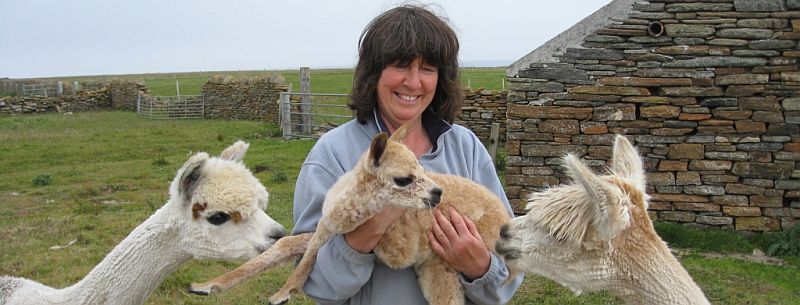|
This is Maya our first
born cria. She is looking at her mum Blanco while the herd leader
Gretel looks on approvingly. Alpacas seem to be more social and vocal
than our sheep, they can't bear to be separated and the herd
instinct over-rides everything.
Alpaca birth and
gestation
Maya's birth was "a baptism of fire for us" taking over
two hours with Blanco screaming throughout. The presentation was front
legs out and head back. A problem relatively easily corrected in
sheep. But, with the cria's long neck, head back is a long way back in
alpacas.
Other islanders rallied round, Stewart our
cattle farmer neighbour acted as midwife, assisted by Norman from
Breckan. Through the birth Linda their previous owner in Cumbria
stood anxiously by the phone giving much needed
advice.
Later in the year Inti and Jallu arrived
in minutes with no problems at all. Much later in the year in
Jallu's case. The average gestation for an alpaca is around 11 months but
there is wide variation. Jallu took 14
months.
The only other health issue was Inti in his
first winter with Vitamin D deficiency. He was taken into intensive
care with his mum for company. They were both given injections of Vitamin D
and Inti made a full
recovery.
Alpaca
nutrition
The rough grazing in the fields along the shore seems
to suit the alpacas. We supplement their diet with a rough coarse
mix for sheep. When they arrived we had a bag of camelid mix
ready for them. But we were shocked at the levels of copper in
the various camelid mixes. As biochemists we worried about copper accummulation
in their livers and couldn't bring ourselves to feed it
to our alpacas. Camelids are evidently more copper tolerant than
sheep and toxicity is something that we would not expect
until after several years of accumulation, and then possibly
masked by symptoms of ageing.
Alpacas and the Orkney
climate
When they arrived on
North Ronaldsay from Cumbria in 2009 our starter herd of
alpacas was the most northerly in Britain, although there
are others in Orkney. In some ways the Orkney climate
matches that of their homeland on the Peruvian altiplano. Our alpacas seem
to revel in the high winds, becoming very skittish. Our summer temperature highs
are in the low twenties Celsius similar to the daily highs on
the altiplano. The altiplano is very dry and
unsurprisingly the alpacas don't like rain and retreat indoors when
it gets too much for them. Thankfully the Orkney is
not a high rainfall area compared to some other regions of the
UK.
| 